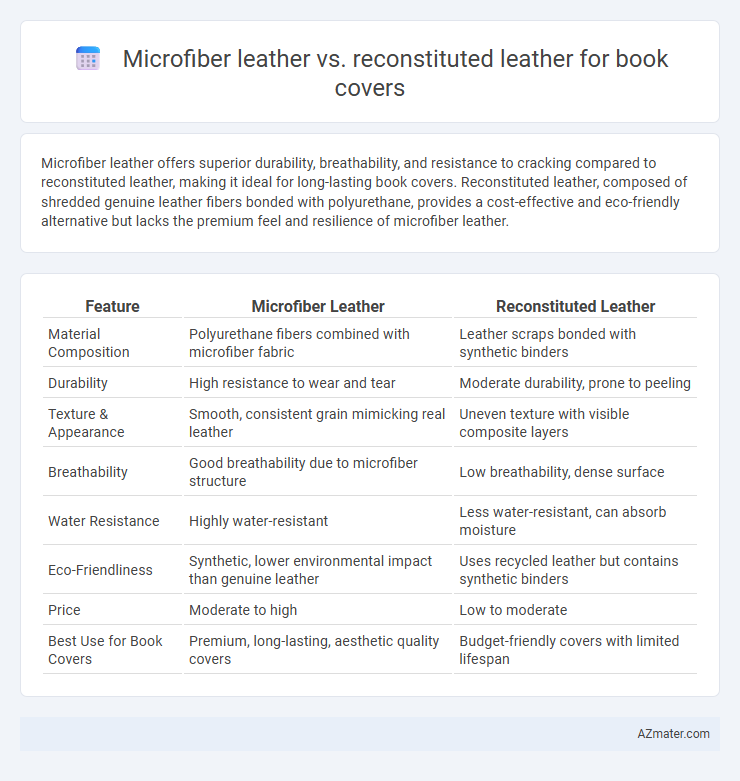Microfiber leather offers superior durability, breathability, and resistance to cracking compared to reconstituted leather, making it ideal for long-lasting book covers. Reconstituted leather, composed of shredded genuine leather fibers bonded with polyurethane, provides a cost-effective and eco-friendly alternative but lacks the premium feel and resilience of microfiber leather.
Table of Comparison
| Feature | Microfiber Leather | Reconstituted Leather |
|---|---|---|
| Material Composition | Polyurethane fibers combined with microfiber fabric | Leather scraps bonded with synthetic binders |
| Durability | High resistance to wear and tear | Moderate durability, prone to peeling |
| Texture & Appearance | Smooth, consistent grain mimicking real leather | Uneven texture with visible composite layers |
| Breathability | Good breathability due to microfiber structure | Low breathability, dense surface |
| Water Resistance | Highly water-resistant | Less water-resistant, can absorb moisture |
| Eco-Friendliness | Synthetic, lower environmental impact than genuine leather | Uses recycled leather but contains synthetic binders |
| Price | Moderate to high | Low to moderate |
| Best Use for Book Covers | Premium, long-lasting, aesthetic quality covers | Budget-friendly covers with limited lifespan |
Introduction: Microfiber Leather vs Reconstituted Leather for Book Covers
Microfiber leather offers superior durability and water resistance compared to reconstituted leather, making it ideal for book covers that require long-lasting protection. Reconstituted leather, made from shredded leather fibers bonded with adhesives, provides an affordable alternative but lacks the resilience and texture of microfiber leather. The choice impacts the book cover's aesthetics, tactile feel, and overall lifespan, with microfiber leather delivering a premium, consistent finish.
What is Microfiber Leather?
Microfiber leather is a high-performance synthetic material made from finely woven microfibers combined with a polyurethane coating, offering durability, breathability, and a soft touch ideal for book covers. Unlike reconstituted leather, which is crafted from shredded leather scraps bonded together, microfiber leather mimics the texture and appearance of genuine leather without using animal products. Its resistance to wear, water, and stains makes microfiber leather a premium choice for long-lasting and elegant book covers.
What is Reconstituted Leather?
Reconstituted leather, also known as bonded leather, is made by shredding genuine leather scraps and fibers which are then bonded together with polyurethane or latex onto a fiber or paper backing. In comparison, microfiber leather is a synthetic material crafted from fine polyester fibers combined with a polyurethane coating, offering higher durability and resistance to wear. For book covers, reconstituted leather provides an affordable, eco-friendly option with a natural leather appearance, while microfiber leather delivers superior water resistance and longer-lasting structural integrity.
Appearance and Texture Comparison
Microfiber leather features a smooth, consistent grain pattern that closely mimics genuine leather, offering a soft, supple texture ideal for premium book covers. Reconstituted leather, made from shredded leather fibers bonded with polyurethane, typically presents a less uniform surface with a slightly rougher feel and visible synthetic overlay. In terms of appearance, microfiber leather provides a more natural and refined look, while reconstituted leather tends to have a less authentic aesthetic with potential inconsistencies in texture.
Durability and Longevity
Microfiber leather offers superior durability and longevity compared to reconstituted leather, as its densely woven synthetic fibers resist wear, scratches, and moisture more effectively. Reconstituted leather, composed of leather scraps bonded together, tends to degrade faster, showing cracks and peeling with prolonged use. For book covers, microfiber leather ensures extended protection and maintains its appearance over time, making it a more resilient choice.
Environmental Impact and Sustainability
Microfiber leather for book covers offers superior environmental benefits due to its production process, which uses fewer natural resources and lowers carbon emissions compared to animal-derived materials. Reconstituted leather, often made from bonded leather scraps mixed with synthetic materials, can contribute to waste reduction but may contain adhesives and coatings that hinder biodegradability. Choosing microfiber leather supports sustainability goals by minimizing chemical use and promoting durability, making it an eco-friendlier option for long-lasting book covers.
Cost-Effectiveness
Microfiber leather offers superior cost-effectiveness for book covers due to its durability and lower production expenses compared to reconstituted leather, which often requires more processing and chemical treatments. The synthetic nature of microfiber leather ensures consistent quality and reduces the risk of wear and tear, extending the lifespan of the book cover while minimizing replacement costs. Reconstituted leather, while cheaper upfront, tends to degrade faster, potentially increasing long-term expenses related to maintenance and replacement.
Ease of Maintenance and Cleaning
Microfiber leather offers superior ease of maintenance for book covers due to its dense synthetic fibers that resist stains and allow for simple wiping with a damp cloth. Reconstituted leather, made from shredded leather scraps bonded with adhesives, tends to absorb spills and dirt more easily, complicating cleaning. Choosing microfiber leather ensures long-lasting cleanliness and minimal upkeep, enhancing the durability and appearance of book covers over time.
Applications and Suitability for Book Covers
Microfiber leather offers superior durability, water resistance, and a smooth texture ideal for high-quality book covers demanding long-term use and aesthetic appeal. Reconstituted leather, made from bonded leather scraps, provides a cost-effective option but lacks the strength and moisture resistance necessary for frequently handled books. Microfiber leather's breathable properties also prevent warping, making it more suitable for premium and archival book covers compared to reconstituted leather.
Conclusion: Choosing the Right Material for Book Covers
Microfiber leather offers superior durability, resistance to wear, and a more consistent texture compared to reconstituted leather, making it ideal for book covers requiring long-lasting quality. Reconstituted leather, while more affordable and environmentally friendly due to its use of leather scraps bonded with adhesives, often lacks the strength and premium feel of microfiber alternatives. Selecting microfiber leather ensures enhanced protection and aesthetic appeal for high-end book covers, whereas reconstituted leather suits budget-conscious projects with moderate durability needs.

Infographic: Microfiber leather vs Reconstituted leather for Book cover
 azmater.com
azmater.com